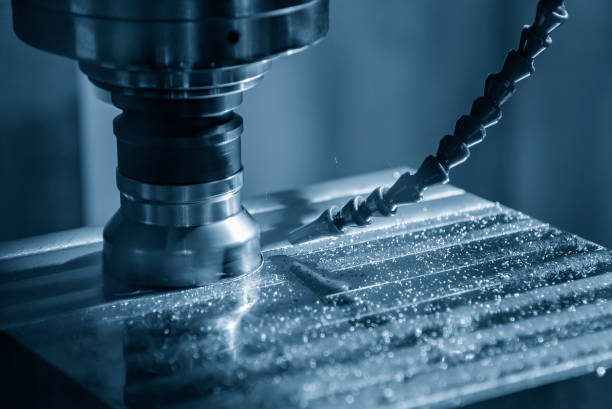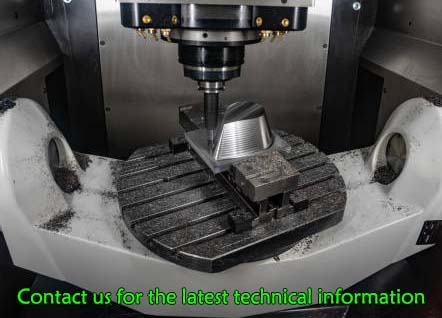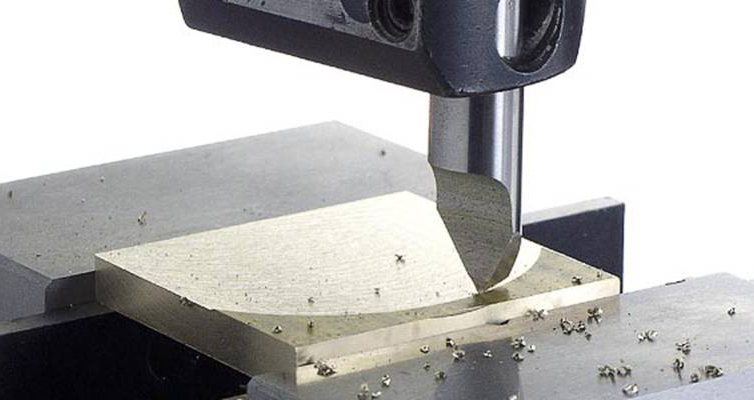In today's modern world, you may have noticed Computer Numerical Control machines are taking the manufacturing industry by storm. They not only control a wide variety of complex machinery but also help in the production of different machine parts and prototypes. This means if you choose a CNC machine for fabricating your machine parts, your product will be produced in less time with less waste material and a minimum risk of human error. In short, a CNC machine efficiently enables you to get your desired high-quality three-dimensional product.
However, you may wonder what makes these machines so accurate and versatile. Well, you should consider two things here. First is their computerized nature, which makes them game-changing technology in terms of accuracy and efficiency. While the second is near-endless options for cutting tools. Now what are cutting tools? Let's explore them in this article. We have brought you deep research about different cutting tools used in CNC machines, how do they function, and where they can help you. So, let's get started!
Before we delve into the types of cutting tools used in CNC machines, you need to know what cutting tools exactly are. Remember, these tools are called cutting tools even though the procedure isn't named cutting in CNC. Rather we call it the milling procedure. Therefore, cutting tools are also called CNC milling cutters or CNC cutters.
Their function is to remove material from a solid block of material. In other words, they help you in the 3D cutting of a material by a shear deformation process. These sharp tools rotate at a very high speed that the material is cut into many small chips and ejected away from the workpiece. So, you get the required shape, dimensions, as well as size of the material.

Choosing the cutting tools is crucial if you want precise and efficient material removal. Different types of cutting tools available in the market help you design the geometry of your part more quickly and smoothly. So below are the most important 8 tools used in CNC machines. Let's start examining their functionality, application, and comparative analysis.
End mills are versatile cutting tools primarily used in milling operations, where they remove material from a workpiece by rotating the tool along its axis while simultaneously moving it laterally. These tools feature cutting edges at the tip (or "end") and along the sides, allowing them to perform various cutting actions.
End mills find extensive applications across industries, including manufacturing, aerospace, automotive, and electronics. Some common applications include:
Contouring: End mills are used to create complex shapes and contours on a workpiece, such as moulds, dies, and 3D profiles.
Slotting: They excel at cutting slots or grooves into a material, commonly seen in keyways, channels, and internal features.
Pocketing: End mills are ideal for removing material to create pockets or recesses in a workpiece, often used for housing components or creating precise geometries.
Drilling: With the proper design, end mills can also perform drilling operations, producing accurate holes in a variety of materials.
Finishing: End mills with specialized coatings and geometries are used for finishing operations, providing smooth surface finishes and tight tolerances.

Face mills are cutting tools used in milling operations to remove material from the surface of a workpiece. They consist of a circular body with multiple cutting edges arranged around the periphery. The cutting edges extend outward from the center of the tool, allowing it to engage with the workpiece across its entire face.

Face mills find applications in various industries, including manufacturing, aerospace, automotive, and construction. Some common applications include:
Facing: Face mills are used to machine flat surfaces on a workpiece, ensuring they are perpendicular to the workpiece's axis.
Surface milling: They are employed for machining large areas of a workpiece to achieve a smooth finish or prepare it for further operations.
Roughing: Face mills are effective for roughing operations where material needs to be removed quickly and efficiently, such as in rough machining of castings or forgings.
Contouring: They can also be used for contouring operations to create complex shapes or profiles on the surface of the workpiece.
Squaring: Face mills are utilized to square up the edges of a workpiece or create precise right angles on its surface.
3. Slab Millings
Slab mills are cutting tools primarily used in milling operations to remove material from large, flat surfaces of a workpiece. They consist of a cylindrical body with cutting teeth on the periphery and sometimes on the face. Slab mills are distinguished by their wide cutting edge, which allows them to cover a broad area of the workpiece in a single pass.
Slab mills find applications in various industries, including manufacturing, construction, and metalworking. Some common applications include:
Facing: Slab mills are used to create flat surfaces on workpieces, ensuring they are smooth and parallel to each other.
Surface milling: They are employed for machining large areas of a workpiece to achieve a uniform finish or prepare it for subsequent operations.
Roughing: Slab mills are effective for roughing operations where high material removal rates are required, such as in the initial stages of machining a rough casting or forging.
Planning: They can be used for planning operations to achieve precise thickness or flatness on the surface of the workpiece.
Slotting: Slab mills can also be used for slotting operations to cut grooves or slots into the surface of the workpiece.

Drill bits are cutting tools used in drilling operations to create holes in a workpiece. They consist of a cylindrical shank with a cutting edge at one end, typically made of high-speed steel (HSS), cobalt steel, or carbide.
The primary function of drill bits is to remove material from a workpiece by rotating them while applying axial force. As the drill bit rotates, the cutting edges engage with the workpiece, gradually removing material to form a hole.
Drill bits find applications across various industries and materials, including metal, wood, plastic, and composites. Some common applications include:
Metalworking: Drill bits are widely used in metalworking operations to create holes in metal components for assembly, fastening, or machining purposes.
Woodworking: They are essential tools in woodworking for drilling holes in wooden boards, furniture, cabinetry, and carpentry projects.
Construction: Drill bits are utilized in construction for tasks such as drilling holes for plumbing, electrical wiring, anchors, and dowels in concrete, masonry, or other building materials.
Automotive: They are employed in automotive repair and maintenance for tasks such as drilling holes for bolts, screws, and rivets in metal parts and components.
DIY and Home Improvement: Drill bits are essential for DIY enthusiasts and home improvement projects, including installing shelves, hanging artwork, assembling furniture, and other household tasks.
Gear cutters are specialized cutting tools used in gear manufacturing processes to produce gears with precise tooth profiles. They consist of multiple cutting edges arranged around the periphery of the cutter, each shaped to correspond with the desired gear tooth profile.
Gear cutters find applications in various industries, including automotive, aerospace, machinery, and industrial equipment manufacturing. Some common applications include:
Gear manufacturing: Gear cutters are essential tools in the production of gears for various mechanical systems, including gearboxes, transmissions, engines, and power transmission equipment.
Gear shaping: They are used in gear shaping machines to cut external and internal gear teeth on cylindrical workpieces, producing gears with precise tooth profiles, pitch, and alignment.
Custom gear production: Gear cutters enable the manufacture of custom gears tailored to specific design requirements, such as gear ratio, tooth profile, and size, for specialized applications and machinery.
Gear repair and refurbishment: Gear cutters are employed in gear repair workshops to re-cut or re-profile damaged or worn gear teeth, extending the service life of gears and restoring their functionality.
Prototype development: They are used in prototype development and research projects to produce gears for testing and evaluation purposes, allowing engineers to refine gear designs and optimize performance before full-scale production.

Fly cutters are simple but effective cutting tools used in milling machines to create flat surfaces or remove material from workpieces. They consist of a single-point cutting tool (usually a carbide insert or high-speed steel tool bit) mounted on a rotating spindle or arbour.
Fly cutters find applications in various machining operations, including:
Surface milling: They are commonly used for surface milling operations to create smooth, flat surfaces on workpieces, such as mounting surfaces, tabletops, and machine beds.
Squaring: Fly cutters are employed to square up the edges of workpieces or remove excess material to achieve precise dimensions and squareness.
Finishing: They can be used for finishing operations to improve surface finish quality and achieve tight tolerances on machined surfaces.
Deburring: Fly cutters are effective for removing burrs and sharp edges from workpieces, resulting from previous machining operations or material handling processes.
Prototype machining: They are often used in prototype development and low-volume production environments to quickly and efficiently machine flat surfaces and simple geometries on workpieces.
Hollow mills, also known as tube mills or core drills, are cutting tools used primarily in lathe operations for the internal machining of cylindrical workpieces. They consist of a hollow cylindrical body with cutting teeth on the outer diameter and a centre hole for mounting on a lathe arbor or mandrel.
Hollow mills find applications in various industries, including automotive, aerospace, machining, and tool and die making. Some common applications include:
Boring: Hollow mills are used to enlarge or refine existing holes in workpieces to achieve precise dimensions and tolerances. They are commonly employed in engine cylinder bore machining, valve seat machining, and bearing housing production.
Reaming: They are utilized for finishing operations to improve the accuracy, surface finish, and dimensional consistency of drilled or bored holes. Reaming with hollow mills ensures tight tolerances and smooth surface finishes in critical applications such as precision machinery components and hydraulic cylinders.
Counterboring: Hollow mills are employed to create recesses or counterbores around existing holes to accommodate fasteners, bearings, or other components with a flush or recessed fit.
Chamfering: They can be used to chamfer or bevel the edges of drilled or bored holes, providing a finished appearance and reducing sharp edges that could cause injury or damage to mating components.
Thread mills are cutting tools used to produce threads in workpieces using a milling machine or a CNC machining center. Unlike traditional taps, which cut threads by rotating and moving linearly into the workpiece, thread mills operate by helically interpolating a thread profile into the workpiece.
Thread mills find applications across various industries, including automotive, aerospace, manufacturing, and robotics. Some common applications include:
Thread milling: Thread mills are used to machine internal and external threads in a wide range of materials, including metals, plastics, and composites. They offer advantages such as improved tool life, reduced cutting forces, and the ability to produce threads close to the bottom of blind holes.
Multi-start threads: They are employed for machining multi-start threads, which have multiple thread starts or leads, allowing for faster assembly and disassembly of threaded connections. Thread mills can produce multi-start threads with precise pitch relationships and thread depths.
Hard materials: Thread mills are suitable for machining threads in hard materials such as hardened steel, stainless steel, and titanium, where traditional tapping methods may be challenging or impractical due to tool wear or material hardness.
Complex thread profiles: They can machine threads with complex profiles, including acme threads, buttress threads, square threads, and trapezoidal threads, to meet specific design requirements and functional needs in mechanical assemblies and components.
Reamers are precision cutting tools used in machining operations to enlarge and refine the dimensions of existing holes in workpieces. They consist of a cylindrical body with cutting edges along the flutes and a tapered or square end for mounting in a machine tool, such as a drill press or milling machine.
Reamers find applications in various industries, including aerospace, automotive, manufacturing, and tool and die making. Some common applications include:
Hole finishing: Reamers are used to refine the dimensions and surface finish of drilled or bored holes, ensuring they meet tight tolerances and provide a smooth mating surface for shafts, pins, bolts, or other components.
Size adjustment: They are employed to adjust the size of existing holes to accommodate specific fasteners, bearings, or other components with precise fit and clearance requirements.
Tapered holes: Reamers can be used to create tapered holes or countersinks for applications such as seatings, keyways, or chamfers, where a precise taper angle or depth is essential for proper function and alignment.
Batch production: Reamers are suitable for high-volume production environments, where consistent hole dimensions and surface finish are critical to maintaining product quality and performance.
Tool maintenance: They are utilized in tool maintenance and repair workshops to restore or resize worn or damaged holes in machine parts, tooling, dies, and fixtures.

Slitting saws are specialized cutting tools used in machining operations to cut narrow slots or grooves in workpieces. They consist of a thin, disc-shaped body with multiple teeth or cutting edges along the circumference.
Slitting saws find applications in various industries, including metalworking, woodworking, plastic fabrication, and electronics manufacturing. Some common applications include:
Slotting: Slitting saws are used to cut slots or channels in workpieces to accommodate keys, fasteners, or other components in mechanical assemblies.
Parting-off: They are employed for parting-off operations to separate individual components from a larger workpiece or stock material, such as cutting off excess material from bar stock or tubing.
Thin cutting: Slitting saws are suitable for cutting thin or delicate materials, such as sheet metal, plastic films, and electronic components, without causing deformation or damage to the workpiece.
Keyway cutting: They can be used to machine keyways or keyseat slots in shafts, gears, pulleys, and other rotating components to accommodate keys or splines for power transmission.
Grooving: Slitting saws are utilized to cut grooves or channels in workpieces for decorative or functional purposes, such as creating flutes on architectural moldings or channels for wiring in electrical enclosures.
In summary, the ten cutting tools highlighted here are the backbone of CNC machining, enabling precision, efficiency, and innovation in manufacturing. From end mills to slitting saws, each tool serves a unique purpose, driving progress and pushing the boundaries of what's possible. With advancing technology, mastering these tools will remain crucial for shaping the future of CNC machining and beyond.